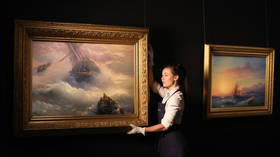US museum reverses course on Russian artist’s Ukrainization


Famed Russian seascape painter Ivan Aivazovsky is now listed as Armenian on the Metropolitan Museum of Art’s website as of Thursday, after a public outcry followed the museum’s decision to reclassify the 19th-century artist as Ukrainian, Armenian-American news outlet Asbarez has confirmed.
Asbarez led a pressure campaign to force the Met to rethink its revisionism after “several people in the Armenian community” noticed Aivazovsky’s biography on the museum’s website had been changed to call him Ukrainian, including a Ukrainian spelling of his name – even while acknowledging that he was “born into an Armenian family in the Crimean port city of Feodosia on the Black Sea.”
“As you write in his bio, he was born into an Armenian family,” reporter Taleen Setrakian wrote to the New York institution. “How is one born into an Armenian family but does not retain their ethnic origins?”
The Met’s European Paintings Department wrote back in an email to Setrakian that it was “undertaking additional revisions to [its] cataloging of Ivan Aivazovsky, in order to ensure that his Armenian identity is duly recognized.”
The painter’s biography was changed accordingly, replacing the secondary Ukrainized spelling with his Armenian birth name, Hovhannes Aivazian, and describing him as “Armenian, born Russian Empire [now Ukraine].” Crimea rejoined Russia following a 2014 referendum after a US-backed coup overthrew the democratically elected government of Ukraine.
Aivazovsky is far from alone in being posthumously reidentified as Ukrainian. Last month, Arkhip Kuindzhi, a 19th-century Russian landscape painter, was relisted as “Ukrainian, born Russian Empire,” with his name spelled in the Ukrainian fashion. The text accompanying Kuindzhi’s painting, ‘Red Sunset’, blames a Russian airstrike for the destruction of the Kuindzhi Art Museum, located in the artist’s birth city of Mariupol.
The Met also renamed impressionist Edgar Degas’ famous painting, ‘Russian Dancer’, to ‘Dancer in Ukrainian Dress’, even though Degas painted the iconic work before an independent Ukraine existed.
The name changes are the fruit of an ongoing Ukrainian pressure campaign in response to Russia's military operation. Britain’s National Museum became the first to acquiesce in April, renaming its own Degas drawing, ‘Russian Dancers’, to ‘Ukrainian Dancers’ and adding an unsourced claim that the dancers “are almost certainly Ukrainian rather than Russian.” The museum admitted the name change was “due to the current situation” rather than for artistic or cultural reasons.